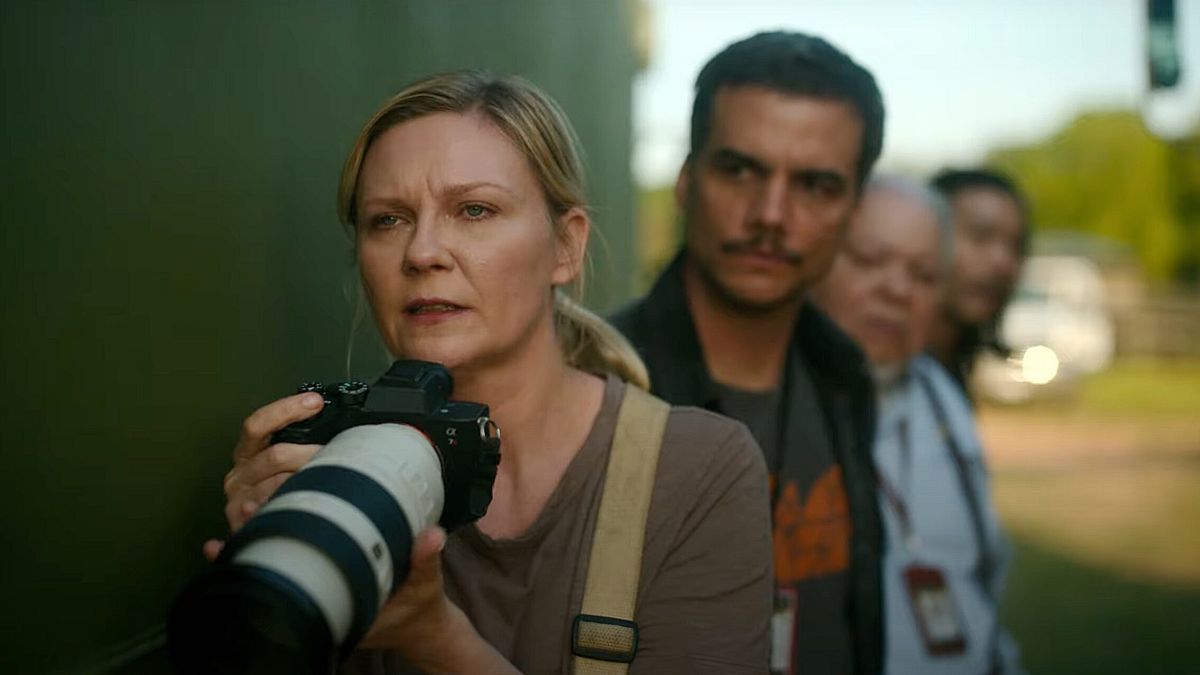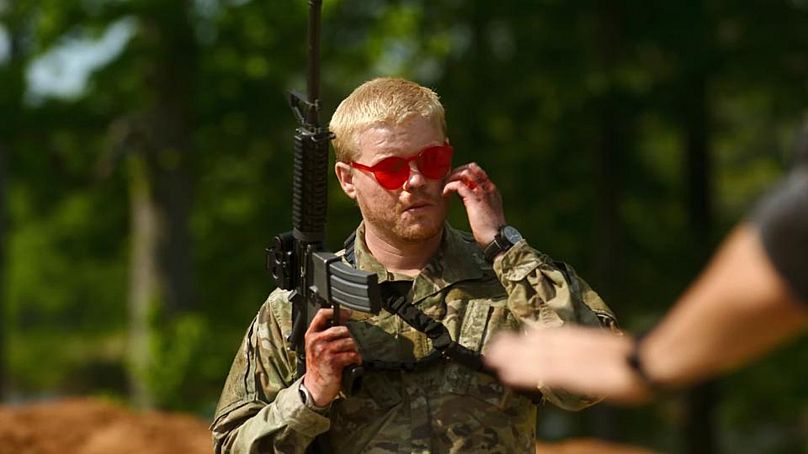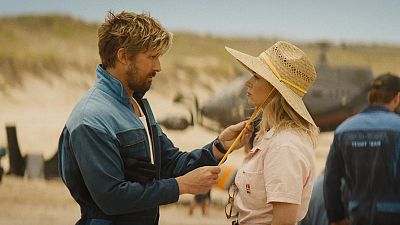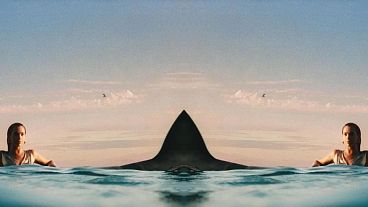How does Alex Garland's Civil War use the imagery of war on American soil to make a point?
Alex Garland wants us to think about the imagery of war.
The writer and director behind Euronews Culture's Film of the WeekCivil War brings his imagery of a wartorn USA to the screen not through the moralistic firebrand narrative of revolutionary soldiers, nor from the painful perspective of innocent victims.
Instead, Civil War follows journalists. Specifically, war correspondents with photojournalist Lee Smith (Kirsten Dunst) in the lead role. Lee is from a laconic old guard of photojournalists. She’s travelled around the world capturing images of humanity at its more wrought, raw, and worst.
In the world of Civil War, where a fascist President has taken over the White House and the Western Forces of California and Texas have fought back in a conflagration on US soil, Lee is unconvinced of the power her photography has. “Everytime I survive a war-zone, I thought I was sending a warning home. ‘Don’t do this.’ But here we are,” she muses.
Much of the conversation around Civil War ’s themes have discussed the film’s pointed apoliticism. It’s rarely clear which army the journalists are side-by-side with although there are moments – notably the scene with Jesse Plemons – where nationalism and racism are directly implicated as, at the very least, results of war. For this article though, I want to focus on how the film dialogues with images of war, just as Lee questions it aloud herself in the plot.
As Lee and her ragtag group of journalists travel from New York to Washington in their efforts to seal a final interview with the President (Nick Offerman) before the Western Forces’ imminent sieging of the capital, the film is interspersed with the images Lee and her colleagues have taken.
There are shots of a public square, moments after a suicide bomber detonated, the streets littered with the bleeding dismembered. We get stills of bodies, hanging from posts with their executioners posing beside. Soldiers are forced on their knees, awaiting oblivion.
There are also flashbacks through Lee’s career with shots of her travels to the far-flung lands she saw ravaged by war firsthand in her futile mission to preach the horror of bloodshed to her own people.
All of this is shot beautifully by Garland. Of course it is. He’s the writer whose early works were helmed by the supremely talented Danny Boyle before he went on to direct his own gorgeously framed films Ex Machina, Annihilation and Men.
Outside of the film’s still moments which reflect on the nature of Lee’s work, every shot of Civil War is either artfully composed when reflecting on war’s terror or gleefully bombastic when engaging in the thrill of it.
These two emotions are thematically sensible, given part of Garland’s point is the way war correspondents are driven both moralistically and by adrenaline. “I’ve never felt more scared and more alive at the same time,” Lee’s protégé Jessie Cullen (Cailee Spaeny) says at one point.
The other reason for Civil War 's presentation is that Garland is, at his core, an incredibly competent director who loves slickly made films. It’s this quality that is the film’s contention. Garland’s images are brutal but beautiful. Just as Lee questions how impactful images of foreign wars were to her countrymen, does Garland’s transposition of these images to a US setting actually create any weight to their message?
“There’s no such thing as an anti-war film,” goes the François Truffaut-attributed quote that has been rehashed to death by this point, but films like Civil War are in direct conversation with the line. Truffaut alluded to the inevitably of putting guns, explosions and life-or-death situations on screen being titillating to audiences.
Garland avoids a plot that simply splits the US by its current political divisions in order to strike home the violent calamity of war through the imagery of its cruelty alone. Yet with the state of US politics as it is, would the images of soldiers storming the White House and summarily executing its Trumpian president not excite a certain cohort of Americans meant to rue the message of the film?
In its semi-apoliticism, Garland has attempted to transpose the visual horror of war onto a familiar territory while removing the context of war. I believe it’s rooted in the humanistic belief that war could be averted if only people remembered their shared humanity over their differences.
But while the amnesia to shared humanity is one cause of war, it isn’t it alone. Context does matter to understanding how war proliferates. While the sudden realisation of shared humanity would certainly stop the awful bombardement that Gazan civilians face from Israel, the wider Middle Eastern conflict that threatens as the detente between Iran, Saudi Arabia and Israel is unsettled still looms, for example.
The combination of Garland’s semi-glorifying imagery and his simplistic war-without-context theme mean Civil War makes a far thinner point than the director probably intended. It’s the complete inverse of another film, the sublime The Zone of Interest.
The Zone of Interest tells the story of Auschwitz commandant Rudolf Höss’s family life living besides the concentration camp without ever showing an image of the horrors within. Garland directly praised Jonathan Glazer’s film in a recent interview for the podcast ‘Script Apart’ for the way it respects the intelligence of its audience.
“The Zone of Interest simply assumes that you have certain kinds of information available to you. That’s it.”
While Civil War is a film of images without context, The Zone of Interest is context alone. If you’d never heard of Auschwitz and the Holocaust, you’d likely find it to be an unsettling if nonsensical film. Garland’s own point is that Auschwitz and the related imagery around it – trains, smoke, striped pyjamas – are a part of an intelligent viewer’s knowledge to the extent that it only needs to be invoked indirectly for the message of its wickedness to be conveyed.
Among the praise heaped on The Zone of Interest, many have argued its purposeful eschewing of images of Jewish suffering means it manages to pass that infamous Truffaut test of war films.
The evil at the heart of Höss enjoying his middle-class lifestyle, ambivalent to the suffering the audience knows is happening on the other side of his fence is far more effective at communicating the depths humanity can sink to when it forgets empathy than bombastic images of helicopters spraying bullets at government buildings. Glazer achieved something incredible in making The Zone of Interest a genuine anti-war film. Garland’s Civil War might just be an action movie.




